by Ed McDonough
There are cars and there are cars.
I like to work on my personal list of the greatest/most desirable racing machines of all time, and then check off the ones I’ve driven. The list is at 72 out of a possible 100 and I have managed 20 so far, lucky person that I am---Ferrari 268SP, GTO, Jaguar C-Type---all with significant history.
The Lancia D50 would have been on the list, naturally, though I knew some time ago that it would never be driven. The two surviving machines reside quietly in the Lancia and Biscaretti Museums in Turin, and never run. However, I was towed around in one of them at the end of a rope, but that hardly counts.
Then a few years ago, Guido Rosani, the son of a former Lancia employee, took one step further an idea he had nurtured since boyhood. Guido’s father had carefully ‘conserved’ many of the Lancia D50 engines, transaxles and other spares after that fateful July day in 1955 when all but two of the Lancia Grand Prix cars were shipped off to Enzo Ferrari as Gianni Lancia’s empire collapsed. Guido had thought ‘one day I will build the cars again’, and so, with the help of a British consortium, he did. The idea was to recreate four of the early D50s and two of the later cars with ‘merged’ bodywork extending over the wonderful fuel panniers which hung between the wheels. Orders for the cars were quick in coming.
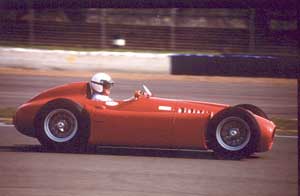 D50 being driven by author at Silverstone, 2002 Credit: Peter Collins
D50 being driven by author at Silverstone, 2002 Credit: Peter Collins
To view larger image click here.
|
The cars were sent to England to the workshops of Jim Stokes, who took them to pieces and rebuilt them with historic racing in mind. The original engines were used along with complete gearbox assemblies and other suspension parts. While arguments took place about the likelihood of the cars getting FIA papers, well known historic racer Robin Lodge ordered one, which duly arrived in April, 2000. Jim Stokes and later Tony Merrick both worked on sorting the car, particularly the handling. Robin Lodge said there was a point when the car would only need to see a corner to spin. He ran it in a number of events and the car, not surprisingly, had a fantastic welcome wherever it went. The arguments about originality became petty once people heard the sound of the very original engine, belting out a modest 260bhp from that lovely V-8.
Having established a rapport with the good Mr. Lodge, I made agreement that I would get a track test in it in the future. That finally came about in April this year at Silverstone, where the Historic Grand Prix Cars Association was holding a test day. Robin said that the handling had been improved by putting in softer springs. In fact, the ones already in use had no movement in them at all.
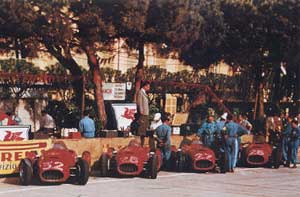 Lancias at Monaco-1955 Author's Collection
Lancias at Monaco-1955 Author's Collection
To view larger image click here.
|
Having contemplated the reality of being the first journalist to do a track test in a D50, I got down to the task in hand. (As it happens, that claim is questionable- one period journalist drove one from the garage at Monaco in 1955, Paul Frere raced one but didn’t write about it, and Brit Willie Green tested this car but didn’t really do a ‘track test’!) All other claims are untrue!
At Silverstone, the car was impressive in the way it delivered power to the ground with great smoothness, superb torque, the gearbox was fluid and exact with no problems at all, and whatever handling gremlins there had been were gone. It was a stunning experience, running in traffic with 246 Dinos, Maserati 250Fs and similar period wonders. The sound was fantastic Italian tuba playing, ebullient and tonal, just a joy to drive.
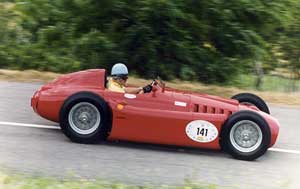 Ed as Ascari At Lugagnano credit: photoagencyRene
Ed as Ascari At Lugagnano credit: photoagencyRene
To view larger image click here.
|
Shortly afterwards, Robin asked if I cared to share the car with him for some runs in the Silver Flag Hillclimb near Piacenza in Italy. Drive the D50 in Italy? I knew I would wake up soon.
The Silver Flag was a 1950s hillclimb from the village of Castell Arquato to Lugagnano to Vernasca, a total of ten kilometres. Resurrected a few years ago, the event now attracts wonderful Italian machines in June for two days of racing and eating. The first half, to Lugagnano, is virtually flat fast bends with no climbing, but a few cones to slow you down as you approach the village, ninety degree left past the bus stop, downhill out of town, and then 4.5 kilometers of steep climb and sixty (!) 2nd and 3rd gear corners. The crowds turned out for day two as Saturday had been rained off, but the D50 was ready to go, and so was I soon replicating the great Alberto Ascari in yellow shirt and blue helmet. It was Ascari ‘s D50 which plunged into the harbour at Monaco in 1955, to be remembered forever.
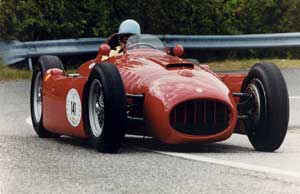 Life is Beautiful, Ed at Lugagno enjoying every second. credit: photoagencyRene
Life is Beautiful, Ed at Lugagno enjoying every second. credit: photoagencyRene
To view larger image click here.
|
The Lodge D50 blasted out from between the crowds that lined both sides of the public road. As I shifted up through the gearbox to top and 7000 rpm, the car was accompanied by the waving of 70 and 80 year old arms from the roadside---the Italian racing memory is long.

|
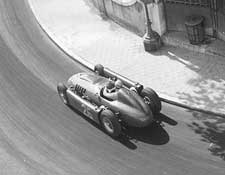 Ascari at Monaco 1955 shortly before the plunge into the sea. Author's
Collection.
Ascari at Monaco 1955 shortly before the plunge into the sea. Author's
Collection.
To view larger image click here.
|
Into Vernasca in second, the car having been flawless through the quick part, the tail waggled as I turned hard left and aimed it downhill, over the bridge at 140 mph and towards the hill, playing the gearbox like a violin, listening to V8 sonatas as the over-square Lancia engine did its business, pulling the iconic racer up the hill. Because it behaves so well, you can think about it, you can take in what you are driving, and you can enjoy it. Second to third to second to third---a rhythm begins to develop…the tail just begins to go, but is always caught with the throttle. The brakes are fine but not that necessary--this is totally a car and a throttle---it all emanates from the right foot.
This is a bit of a cliché, but that was the dream realised. What next?



